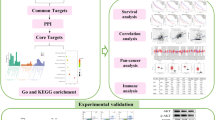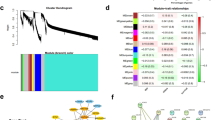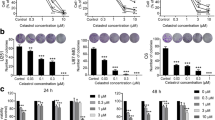Abstract
Bacoside A (gypenoside, Gyp) is a potent bioactive compound derived from Gynostemma pentaphyllum, known to exert inhibitory effects on various malignant tumors. However, the effects of Gyp on glioma as well as the underlying mechanisms remain unclear. In the present study, we first conducted a comprehensive investigation into the anti-glioma potential of gypenosides using network pharmacology to identify potential glioma-related targets. Protein–protein interaction networks were assembled, and GO and KEGG enrichment analyses were performed for shared targets. Experimental validation involved assessing the viability of U251 and U87 cell lines using the MTS method. Furthermore, trans-well and scratch migration assays evaluated the cell migration, while flow cytometry and Hoechst 33342 staining were utilized for apoptosis assessment. The study also monitored changes in autophagy flow through fluorescence microscopy. The expression levels of proteins pertinent to migration, apoptosis, and autophagy were tested using Western blotting. Findings revealed that Gyp upregulated apoptosis-related proteins (Bax and cleaved caspase-9), downregulated anti-apoptotic protein Bcl-2, and migration-associated matrix metalloproteinases (MMP-2 and MMP-9). Furthermore, autophagy-related proteins (Beclin1 and LC3 II) were upregulated, and p62 protein expression was downregulated. Gyp displayed considerable potential in suppressing glioma progression by inhibiting cell proliferation, invasion, and migration and promoting apoptosis and autophagy. Gyp may offer potential clinical therapeutic choices in glioma management.
Graphical Abstract









Similar content being viewed by others
Data availability
The data that support the findings of this study are available from the corresponding authors.
Abbreviations
- Gyp:
-
Bacoside A (Gypenoside)
- MMP:
-
Migration-associated matrix metalloproteinases
- TMZ:
-
Temozolomide
- TCMSP:
-
Traditional Chinese Medicine Systems Pharmacology platform
- GO:
-
Gene ontology
- KEGG:
-
Kyoto Encyclopedia of Genes and Genomes
- CC:
-
Cell composition
- MF:
-
Molecular function
- BP:
-
Biological process
- OB:
-
Oral bioavailability
- PPI:
-
Protein–protein interaction
References
Chakraborty A, Harkness W, Phipps K (2009) Surgical management of supratentorial ependymomas. Childs Nerv Syst 25:1215–1220
Chen MH, Chen SH, Wang QF, Chen JC, Chang DC, Hsu SL, Chen CH, Sheue CR, Liu YW (2008) The molecular mechanism of Bacoside A-induced G1 growth arrest of rat hepatic stellate cells. J Ethnopharmacol 117:309–317
Chen YY, Chang YM, Wang KY, Chen PN, Hseu YC, Chen KM, Yeh KT, Chen CJ, Hsu LS (2019) Naringenin inhibited migration and invasion of glioblastoma cells through multiple mechanisms. Environ Toxicol 34:233–239
Dong Y, Wu Y, Zhao GL, Ye ZY, Xing CG, Yang XD (2019) Inhibition of autophagy by 3-MA promotes hypoxia-induced apoptosis in human colorectal cancer cells. Eur Rev Med Pharmacol Sci 23:1047–1054
Fei M, Zhang L, Wang H, Zhu Y, Niu W, Tang T, Han Y (2020) Inhibition of cathepsin S induces mitochondrial apoptosis in glioblastoma cell lines through mitochondrial stress and autophagosome accumulation. Front Oncol 10:516746
Guo QL, Dai XL, Yin MY, Cheng HW, Qian HS, Wang H, Zhu DM, Wang XW (2022) Nanosensitizers for sonodynamic therapy for glioblastoma multiforme: current progress and future perspectives. Mil Med Res 9:26
Han J, Gao W, Su D, Liu Y (2018) Gyp inhibits RANKL-induced osteoclastogenesis by regulating NF-κB, AKT, and MAPK signaling pathways. J Cell Biochem 119:7310–7318
Kong L, Wang X, Zhang K, Yuan W, Yang Q, Fan J, Wang P, Liu Q (2015) Bacoside a synergistically enhances the anti-tumor effect of 5-fluorouracil on colorectal cancer in vitro and in vivo: A Role for Oxidative Stress-Mediated DNA Damage and p53 Activation. PLoS ONE 10:e0137888
Li LQ, Xie WJ, Pan D, Chen H, Zhang L (2016a) Inhibition of autophagy by bafilomycin A1 promotes chemosensitivity of gastric cancer cells. Tumour Biol 37:653–659
Li Y, Lin W, Huang J, Xie Y, Ma W (2016) Anti-cancer effects of Gynostemma pentaphyllum (Thunb) Makino (Jiaogulan). Chin Med 11:43
Li H, Yuan X, Yan D, Li D, Guan F, Dong Y, Wang H, Liu X, Yang B (2017) Long non-coding RNA MALAT1 decreases the sensitivity of resistant glioblastoma cell lines to temozolomide. Cell Physiol Biochem 42:1192–1201
Li Y, Wang D, Liu J, Li Y, Chen D, Zhou L, Lang T, Zhou Q (2020) Baicalin attenuates YAP activity to suppress ovarian cancer stemness. Onco Targets Ther 13:7151–7163
Lin JJ, Hsu HY, Yang JS, Lu KW, Wu RS, Wu KC, Lai TY, Chen PY, Ma CY, Wood WG, Chung JG (2011) Molecular evidence of anti-leukemia activity of Bacoside A on human myeloid leukemia HL-60 cells in vitro and in vivo using a HL-60 cells murine xenograft model. Phytomedicine 18:1075–1085
Lu KW, Tsai ML, Chen JC, Hsu SC, Hsia TC, Lin MW, Huang AC, Chang YH, Ip SW, Lu HF, Chung JG (2008) Bacoside A inhibited invasion and migration of human tongue cancer SCC4 cells through down-regulation of NFkappaB and matrix metalloproteinase-9. Anticancer Res 28:1093–1099
Lu KW, Chen JC, Lai TY, Yang JS, Weng SW, Ma YS, Tang NY, Lu PJ, Weng JR, Chung JG (2010) Bacoside A causes DNA damage and inhibits expression of DNA repair genes of human oral cancer SAS cells. In Vivo 24:287–291
Lu KW, Chen JC, Lai TY, Yang JS, Weng SW, Ma YS, Lu PJ, Weng JR, Chueh FS, Wood WG, Chung JG (2011) Bacoside A inhibits migration and invasion of human oral cancer SAS cells through the inhibition of matrix metalloproteinase-2 -9 and urokinase-plasminogen by ERK1/2 and NF-kappa B signaling pathways. Hum Exp Toxicol 30:406–415
Meng X, Wang M, Sun G, Ye J, Zhou Y, Dong X, Wang T, Lu S, Sun X (2014) Attenuation of Aβ25-35-induced parallel autophagic and apoptotic cell death by Gyp XVII through the estrogen receptor-dependent activation of Nrf2/ARE pathways. Toxicol Appl Pharmacol 279:63–75
Muscella A, Vetrugno C, Cossa LG, Marsigliante S (2020) TGF-β1 activates RSC96 Schwann cells migration and invasion through MMP-2 and MMP-9 activities. J Neurochem 153:525–538
Pang M, Fang Y, Chen S, Zhu X, Shan C, Su J, Yu J, Li B, Yang Y, Chen B, Liang K, Hu H, Lv G (2017) Bacoside A inhibits xanthine oxidoreductase and ameliorates urate excretion in hyperuricemic rats induced by high cholesterol and high fat food (Lipid Emulsion). Med Sci Monit 23:1129–1140
Phu HT, Thuan DTB, Nguyen THD, Posadino AM, Eid AH, Pintus G (2020) Herbal medicine for slowing aging and aging-associated conditions: efficacy, mechanisms and safety. Curr Vasc Pharmacol 18:369–393
Sheng B, Song Y, Zhang J, Li R, Wang Z, Zhu X (2020) Atorvastatin suppresses the progression of cervical cancer via regulation of autophagy. Am J Trans Res 12:5252–5268
Sozen E, Yazgan B, Tok OE, Demirel T, Ercan F, Proto JD, Ozer NK (2020) Cholesterol induced autophagy via IRE1/JNK pathway promotes autophagic cell death in heart tissue. Metabolism 106:154205
Sun DP, Li XX, Liu XL, Zhao D, Qiu FQ, Li Y, Ma P (2013) Bacoside A induce apoptosis by ca2+ overload mediated by endoplasmic-reticulum and store-operated ca2+ channels in human hepatoma cells. Cancer Biother Radiopharm 28:320–326
Tripathi SK, Rengasamy KRR, Biswal BK (2020) Plumbagin engenders apoptosis in lung cancer cells via caspase-9 activation and targeting mitochondrial-mediated ROS induction. Arch Pharm Res 43:242–256
Ulasov I, Fares J, Timashev P, Lesniak MS (2020) Editing cytoprotective autophagy in glioma: an unfulfilled potential for therapy. Trends Mol Med 26:252–262
Wang LL, Liao C, Li XQ, Dai R, Ren QW, Shi HL, Wang XP, Feng XS, Chao X (2021) Systems pharmacology-based identification of mechanisms of action of bolbostemma paniculatum for the treatment of hepatocellular carcinoma. Med Sci Monit 27:e927624
Wu CH, Gan CH, Li LH, Chang JC, Chen ST, Menon MP, Cheng SM, Yang SP, Ho CL, Chernikov OV, Lin CH, Lam Y, Hua KF (2020) A synthetic small molecule f240b decreases NLRP3 inflammasome activation by autophagy induction. Front Immunol 11:607564
Xiao H, Ye X, Vishwakarma V, Preet R, Dixon DA (2022) CRC-derived exosomes containing the RNA binding protein HuR promote lung cell proliferation by stabilizing c-Myc mRNA. Cancer Biol Ther 23:139–149
Xing SF, Jang M, Wang YR, Piao XL (2016) A new dammarane-type saponin from Gynostemma pentaphyllum induces apoptosis in A549 human lung carcinoma cells. Bioorg Med Chem Lett 26:1754–1759
Xue J, Shi Y, Li C, Song H (2019) Network pharmacology-based prediction of the active ingredients, potential targets, and signaling pathways in compound Lian-Ge granules for treatment of diabetes. J Cell Biochem 120:6431–6440
Yan H, Wang X, Niu J, Wang Y, Wang P, Liu Q (2014) Anti-cancer effect and the underlying mechanisms of Bacoside A on human colorectal cancer SW-480 cells. PLoS ONE 9:e95609
Yang L, Han N, Zhang X, Zhou Y, Chen R, Zhang M (2020a) ZWINT: A potential therapeutic biomarker in patients with glioblastoma correlates with cell proliferation and invasion. Oncol Rep 43:1831–1844
Yang Y, Karsli-Uzunbas G, Poillet-Perez L, Sawant A, Hu ZS, Zhao Y, Moore D, Hu W, White E (2020b) Autophagy promotes mammalian survival by suppressing oxidative stress and p53. Genes Dev 34:688–700
Yang F, Du L, Song G, Zong X, Jin X, Yang X, Qi Z (2021) Rapamycin and 3-methyladenine influence the apoptosis, senescence, and adipogenesis of human adipose-derived stem cells by promoting and inhibiting autophagy: An in vitro and in vivo study. Aesthetic Plast Surg 45:1294–1309
Yuan S, Yan Q, Zhao ZY, Zhang JL, Zhang H, Yin H, Yuan Z (2022) STAT3-mediated upregulation of LINC00520 contributed to temozolomide chemoresistance in glioblastoma by interacting with RNA-binding protein LIN28B. Cancer Cell Int 22:248
Zhang HK, Ye Y, Li KJ, Zhao ZN, He JF (2020) Bacoside A prevent H(2)O(2)-Induced retinal ganglion cell apoptosis by concurrently suppressing the neuronal oxidative stress and inflammatory response. J Mol Neurosci 70:618–630
Zhou L, Wang J, Zhao J, Kuai F, Yang H (2020) Shikonin promotes osteogenesis and suppresses osteoclastogenesis in vitro. Am J Trans Res 12:8099–8110
Funding
This study was supported by the National Natural Science Foundation of China (grant nos. 82060680, 82001383), China Postdoctoral Science Foundation (2023M732302), the Science and Technology Research Project of the Education Department of Jiangxi Province of China (grant nos. GJJ201210 and GJJ200143), the Distinguished Young Scholars Fund of Jiangxi Cancer Hospital (grant no. 2021DYS01). Traditional Chinese Medicine Science Research Fund of Jiangxi Province (grant no. 2022B928, 2019A024).
Author information
Authors and Affiliations
Contributions
Qiaoli Lv drafted articles for important knowledge content and made critical revisions to it, and Dapeng wang planned and monitored the study. Haiyun Liu participated in the article structure design, manuscript drafting and main experimental research. Hong Du and Shuhui Chen is responsible for cell-related experiments; Yulong Ji and Dapeng Wang were responsible for the article writing. All authors read and agree to the final manuscript. The authors declare that all data were generated in-house and that no paper mill was used.
Corresponding authors
Ethics declarations
Ethical approval
No animals were used in this study.
Competing interests
The authors declare no competing interests.
Additional information
Publisher's Note
Springer Nature remains neutral with regard to jurisdictional claims in published maps and institutional affiliations.
Supplementary Information
Below is the link to the electronic supplementary material.
Rights and permissions
Springer Nature or its licensor (e.g. a society or other partner) holds exclusive rights to this article under a publishing agreement with the author(s) or other rightsholder(s); author self-archiving of the accepted manuscript version of this article is solely governed by the terms of such publishing agreement and applicable law.
About this article
Cite this article
Liu, HY., Ji, YL., Du, H. et al. Bacoside a inhibits the growth of glioma by promoting apoptosis and autophagy in U251 and U87 cells. Naunyn-Schmiedeberg's Arch Pharmacol 397, 2105–2120 (2024). https://doi.org/10.1007/s00210-023-02724-x
Received:
Accepted:
Published:
Issue Date:
DOI: https://doi.org/10.1007/s00210-023-02724-x




